
Small and short-lived, Erysimum 'Chelsea Jacket' is a perennial cultivar of Erysimum cheiri usually grown for its long-lasting and brightly coloured flowers. It is closely related to Cheiranthus. This plant has been given an RHS Award of Garden Merit. Normal height is about 30 cm, prostrate habit.
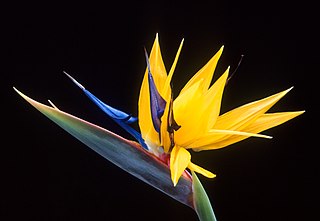
Strelitzia is a genus of five species of perennial plants, native to South Africa. It belongs to the plant family Strelitziaceae. A common name of the genus is bird of paradise flower/plant, because of a resemblance of its flowers to birds-of-paradise. In South Africa, it is commonly known as a crane flower.

Sunbirds and spiderhunters make up the family Nectariniidae of passerine birds. They are small, slender passerines from the Old World, usually with downward-curved bills. Many are brightly coloured, often with iridescent feathers, particularly in the males. Many species also have especially long tail feathers. Their range extends through most of Africa to the Middle East, South Asia, South-east Asia and southern China, to Indonesia, New Guinea and northern Australia. Species diversity is highest in equatorial regions.
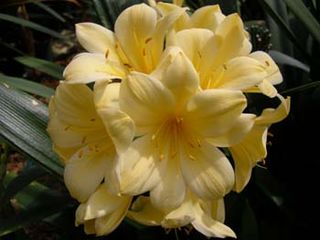
Clivia is a genus of monocot flowering plants native to southern Africa. They are from the family Amaryllidaceae, subfamily Amaryllidoideae. Common names are Natal lily or bush lily.

Primula vulgaris, the common primrose, is a species of flowering plant in the family Primulaceae, native to western and southern Europe, northwest Africa, and parts of southwest Asia. The common name is primrose, or occasionally common primrose or English primrose to distinguish it from other Primula species also called primroses. None of these are closely related to the evening primroses.

Zantedeschia is a genus of eight species of herbaceous, perennial, flowering plants in the family Araceae, native to southern Africa from South Africa north to Malawi. The genus has been introduced on all continents except Antarctica. Common names include arum lily for Z. aethiopica and calla and calla lily for Z. elliottiana and Z. rehmannii, although members of the genus are neither true lilies of Liliaceae, true Arums, nor true Callas. The colourful flowers and leaves of both species and cultivars are greatly valued and commonly grown as ornamental plants.

Gaillardia pulchella is a North American species of short-lived perennial or annual flowering plants in the sunflower family.
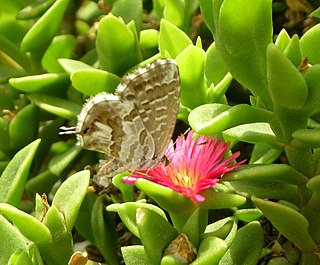
The geranium bronze or brun des pélargoniums in French, is a butterfly in the family Lycaenidae.

Thunbergia alata, commonly called black-eyed Susan vine, is a herbaceous perennial climbing plant species in the family Acanthaceae. It is native to Eastern Africa, and has been naturalized in other parts of the world.

Erysimum cheiri, syn. Cheiranthus cheiri, the wallflower, is a species of flowering plant in the family Brassicaceae (Cruciferae), native to Greece, but widespread as an introduced species elsewhere. It is also treated as a hybrid under the name Erysimum × cheiri. It is widely cultivated as a garden plant.

Gazania rigens, sometimes called treasure flower, is a species of flowering plant in the family Asteraceae, native to coastal areas of southern Africa. It is naturalised elsewhere and is widely cultivated as an ornamental plant.
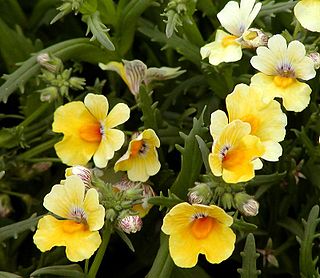
Nemesia is a genus of annuals, perennials and sub-shrubs which are native to sandy coasts or disturbed ground in South Africa. Numerous hybrids have been selected, and the annual cultivars are popular with gardeners as bedding plants. In temperate regions they are usually treated as half-hardy, grown from seed in heat, and planted out after all danger of frost has passed.

Nemesia caerulea is a blue- to purple- flowered herbaceous perennial member of the family Scrophulariaceae. The plant is native to the Cape Floristic Province of southwestern South Africa, where it grows at low elevations on fully exposed north-facing and northwest-facing slopes in association with other native grasses and forbs. Its chromosome number is 2n=18.
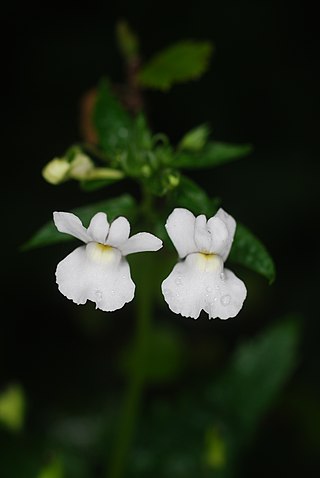
Nemesia floribunda is an erect annual herb that is native to South Africa, but has naturalized elsewhere.

Hypericum undulatum, the wavy St Johns Wort, is a herbaceous perennial flowering plant native to western Europe and northern Africa. The specific name undulatum is Latin, meaning "wavy" or "undulated", referring, just as the common name, to the wavy leaf margins of the herb. The plant has a diploid number of 16 or 32.
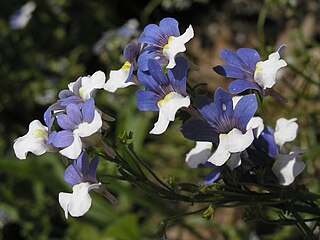
Nemesia strumosa, Cape jewels or pouch nemesia, is a species of flowering plant in the family Scrophulariaceae, native to the southwestern Cape Provinces of South Africa. Suited for garden applications such as beds, borders, rock gardens and containers, its cultivars come in a wide variety of flower colors, including bicolored. When grown as a cool‑weather annual it can be planted in USDA zones 2 through 10.
Nemesia glaucescens is a species of plant endemic to South Africa. It belongs to the figwort family.

Nemesia linearis, also known as the witleeubekkie in Afrikaans, is a species of plant from southern Africa. It is found in South Africa and Namibia.

Nemesia versicolor is a species of perennial flowering plant in the family Scrophulariaceae. It is endemic to the Northern and Western Cape Provinces of South Africa.


















